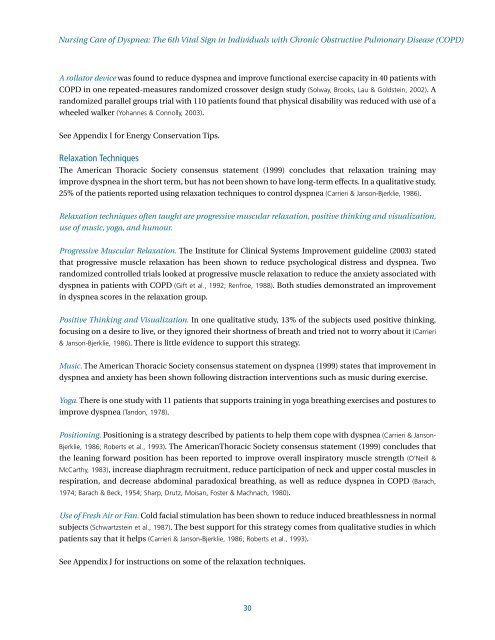Nursing Care of Dyspnea: The 6th Vital Sign in Individuals with ...
Nursing Care of Dyspnea: The 6th Vital Sign in Individuals with ...
Nursing Care of Dyspnea: The 6th Vital Sign in Individuals with ...
Create successful ePaper yourself
Turn your PDF publications into a flip-book with our unique Google optimized e-Paper software.
<strong>Nurs<strong>in</strong>g</strong> <strong>Care</strong> <strong>of</strong> <strong>Dyspnea</strong>: <strong>The</strong> <strong>6th</strong> <strong>Vital</strong> <strong>Sign</strong> <strong>in</strong> <strong>Individuals</strong> <strong>with</strong> Chronic Obstructive Pulmonary Disease (COPD)A rollator device was found to reduce dyspnea and improve functional exercise capacity <strong>in</strong> 40 patients <strong>with</strong>COPD <strong>in</strong> one repeated-measures randomized crossover design study (Solway, Brooks, Lau & Goldste<strong>in</strong>, 2002). Arandomized parallel groups trial <strong>with</strong> 110 patients found that physical disability was reduced <strong>with</strong> use <strong>of</strong> awheeled walker (Yohannes & Connolly, 2003).See Appendix I for Energy Conservation Tips.Relaxation Techniques<strong>The</strong> American Thoracic Society consensus statement (1999) concludes that relaxation tra<strong>in</strong><strong>in</strong>g mayimprove dyspnea <strong>in</strong> the short term, but has not been shown to have long-term effects. In a qualitative study,25% <strong>of</strong> the patients reported us<strong>in</strong>g relaxation techniques to control dyspnea (Carrieri & Janson-Bjerklie, 1986).Relaxation techniques <strong>of</strong>ten taught are progressive muscular relaxation, positive th<strong>in</strong>k<strong>in</strong>g and visualization,use <strong>of</strong> music, yoga, and humour.Progressive Muscular Relaxation. <strong>The</strong> Institute for Cl<strong>in</strong>ical Systems Improvement guidel<strong>in</strong>e (2003) statedthat progressive muscle relaxation has been shown to reduce psychological distress and dyspnea. Tworandomized controlled trials looked at progressive muscle relaxation to reduce the anxiety associated <strong>with</strong>dyspnea <strong>in</strong> patients <strong>with</strong> COPD (Gift et al., 1992; Renfroe, 1988). Both studies demonstrated an improvement<strong>in</strong> dyspnea scores <strong>in</strong> the relaxation group.Positive Th<strong>in</strong>k<strong>in</strong>g and Visualization. In one qualitative study, 13% <strong>of</strong> the subjects used positive th<strong>in</strong>k<strong>in</strong>g,focus<strong>in</strong>g on a desire to live, or they ignored their shortness <strong>of</strong> breath and tried not to worry about it (Carrieri& Janson-Bjerklie, 1986). <strong>The</strong>re is little evidence to support this strategy.Music. <strong>The</strong> American Thoracic Society consensus statement on dyspnea (1999) states that improvement <strong>in</strong>dyspnea and anxiety has been shown follow<strong>in</strong>g distraction <strong>in</strong>terventions such as music dur<strong>in</strong>g exercise.Yoga. <strong>The</strong>re is one study <strong>with</strong> 11 patients that supports tra<strong>in</strong><strong>in</strong>g <strong>in</strong> yoga breath<strong>in</strong>g exercises and postures toimprove dyspnea (Tandon, 1978).Position<strong>in</strong>g. Position<strong>in</strong>g is a strategy described by patients to help them cope <strong>with</strong> dyspnea (Carrieri & Janson-Bjerklie, 1986; Roberts et al., 1993). <strong>The</strong> AmericanThoracic Society consensus statement (1999) concludes thatthe lean<strong>in</strong>g forward position has been reported to improve overall <strong>in</strong>spiratory muscle strength (O’Neill &McCarthy, 1983), <strong>in</strong>crease diaphragm recruitment, reduce participation <strong>of</strong> neck and upper costal muscles <strong>in</strong>respiration, and decrease abdom<strong>in</strong>al paradoxical breath<strong>in</strong>g, as well as reduce dyspnea <strong>in</strong> COPD (Barach,1974; Barach & Beck, 1954; Sharp, Drutz, Moisan, Foster & Machnach, 1980).Use <strong>of</strong> Fresh Air or Fan. Cold facial stimulation has been shown to reduce <strong>in</strong>duced breathlessness <strong>in</strong> normalsubjects (Schwartzste<strong>in</strong> et al., 1987). <strong>The</strong> best support for this strategy comes from qualitative studies <strong>in</strong> whichpatients say that it helps (Carrieri & Janson-Bjerklie, 1986; Roberts et al., 1993).See Appendix J for <strong>in</strong>structions on some <strong>of</strong> the relaxation techniques.30
















